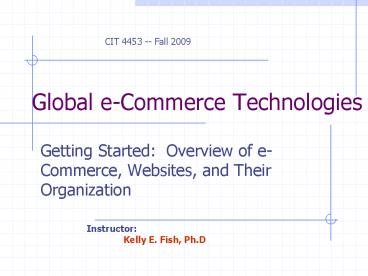Global e-Commerce Technologies - PowerPoint PPT Presentation
1 / 12
Title:
Global e-Commerce Technologies
Description:
It favors intangible things ideas, information, relationships. ... e.g., Craig's list. e.g., Amazon.com. Four Categories of eCommerce. Overview of Web Basics ... – PowerPoint PPT presentation
Number of Views:102
Avg rating:3.0/5.0
Title: Global e-Commerce Technologies
1
Global e-Commerce Technologies
CIT 4453 -- Fall 2009
- Getting Started Overview of e- Commerce,
Websites, and Their Organization
Instructor Kelly E. Fish, Ph.D
2
Week 1 Objectives
- Learn about the class
- Learn some Internet fundamental concepts
- Get started with Dreamweaver
- Complete Lab 1
3
Agenda
- Introductions Professors Students
- Name
- Major Interests
- Hometown
- Overview of Course
- Website clt.astate.edu/kfish
- Syllabus
- Assign Lab1
- eCommerce Concepts/Definitions
- Web Concepts
4
Course Overview/Schematic
Global e-Commerce Web site
Web development assignments
Concepts Principles
-Dreamweaver - Flash -Translation software
- eBusiness Models
- Internet Marketing
- CRM
- Security
- Cultural issues
5
Definition of e-Commerce
The Internet is global. It favors intangible
things ideas, information, relationships. And
it is intensively interlinked. - Kevin
Kelly, New Rules for the New Economy
- e-commerce is characterized by several specific
attributes - It is about the exchange of digitalized
information between parties - It is technology-enabled
- It is technology-mediated
- It includes intra- and inter-organizational
activities that support the exchange
e-Commerce can be defined as technology-mediated
exchange between parties (individuals,
organizations or both) as well as the
electronically based intra- and
inter-organizational activities that facilitate
such exchange
6
Four Categories of eCommerce
Four distinct categories of e-commerce can be
defined, based on the business origination and
the customer type
Business originating from...
Consumers
Business
B2B
C2B
Business
e.g., Monster.com
e.g., Covisint
And selling to...
B2C
C2C
Consumers
e.g., Craigs list
e.g., Amazon.com
7
Overview of Web Basics
- Web file concepts/terminology
- Web page, website, web
- Home page (default.htm, index.html, . . . )
- Object files (e.g., graphic images, sounds,
applets, . . . ) - Browser/server interaction
- User agent (typically running browser) requests
file/page - Then
- Page (and related files) pulled from local cache
- Or server retrieves and sends
- Pages
- Static
- Interactive client side and server side
- Simply a modern means of processing data input,
processing, output
8
Anatomy of a URL
- Example
- http//clt.astate.edu/kfish
- Protocol
- Assumed is http
- Others https, mailto, ftp, file (i.e., local
resource), . . . - Location of the computer (corresponds to IP)
- Domain
- Domain name
- Machine
- Location on the computer
- Folder
- Subfolders
- File extension (.htm, .asp, .html, .php, . . .
) - Bookmark (anchor)
9
What Happens When You View a Web Page?
- Two ways to request resources
- Click on a link
- Type a URL into address bar
- HTTP request is then sent to server at designated
URL - Includes header info
- Requests file
- Server then returns HTTP response
- Includes header info
- Contains file
- Repeated as client (i.e., user agent) interprets
file
10
Browser/Server Interaction
Alternatively resources pulled from cache
11
Markup, Whats That?
- Computer language for describing text
- Standard generalized markup language (SGML)
- Extensible markup language (XML)
- Hypertext markup language
- HTML
- XHTML
- Read as data file by browser
- HTML (or XHTML) file contains
- Content
- Markup
- Can incorporate functionality (JavaScript)
12
Technologies for eCommerce
- Keep in mind, the purpose is to use the right
technologies to support the firms business plan - In general, the technologies with which well be
working can be classified as - Web tools (e.g., Dreamweaver, Flash)
- Web languages (e.g., XHTML)
- Client technologies (web browsers, in particular)































